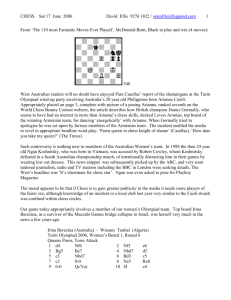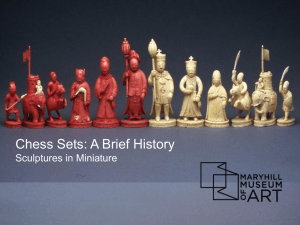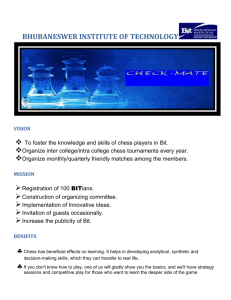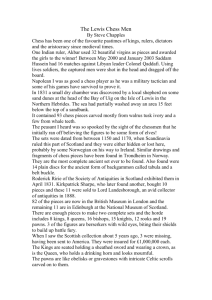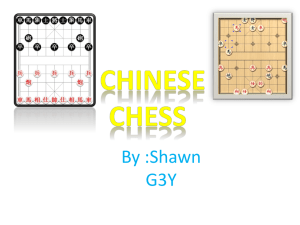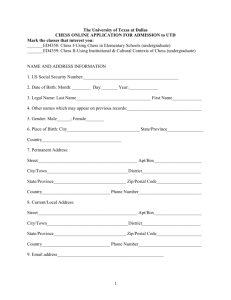Towards the unification of intuitive and formal game concepts with
advertisement
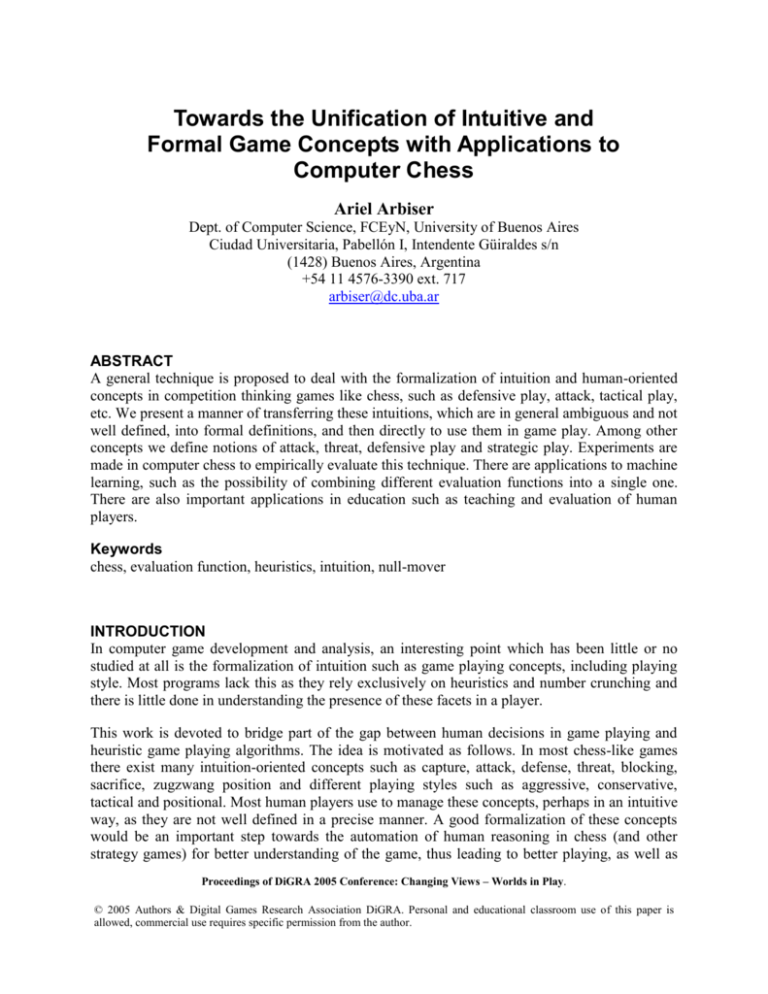
Towards the Unification of Intuitive and Formal Game Concepts with Applications to Computer Chess Ariel Arbiser Dept. of Computer Science, FCEyN, University of Buenos Aires Ciudad Universitaria, Pabellón I, Intendente Güiraldes s/n (1428) Buenos Aires, Argentina +54 11 4576-3390 ext. 717 arbiser@dc.uba.ar ABSTRACT A general technique is proposed to deal with the formalization of intuition and human-oriented concepts in competition thinking games like chess, such as defensive play, attack, tactical play, etc. We present a manner of transferring these intuitions, which are in general ambiguous and not well defined, into formal definitions, and then directly to use them in game play. Among other concepts we define notions of attack, threat, defensive play and strategic play. Experiments are made in computer chess to empirically evaluate this technique. There are applications to machine learning, such as the possibility of combining different evaluation functions into a single one. There are also important applications in education such as teaching and evaluation of human players. Keywords chess, evaluation function, heuristics, intuition, null-mover INTRODUCTION In computer game development and analysis, an interesting point which has been little or no studied at all is the formalization of intuition such as game playing concepts, including playing style. Most programs lack this as they rely exclusively on heuristics and number crunching and there is little done in understanding the presence of these facets in a player. This work is devoted to bridge part of the gap between human decisions in game playing and heuristic game playing algorithms. The idea is motivated as follows. In most chess-like games there exist many intuition-oriented concepts such as capture, attack, defense, threat, blocking, sacrifice, zugzwang position and different playing styles such as aggressive, conservative, tactical and positional. Most human players use to manage these concepts, perhaps in an intuitive way, as they are not well defined in a precise manner. A good formalization of these concepts would be an important step towards the automation of human reasoning in chess (and other strategy games) for better understanding of the game, thus leading to better playing, as well as Proceedings of DiGRA 2005 Conference: Changing Views – Worlds in Play. © 2005 Authors & Digital Games Research Association DiGRA. Personal and educational classroom use of this paper is allowed, commercial use requires specific permission from the author. for simulating the different styles and recognizing different game situations. The goal of this research is to take a first step towards the unification of both “paradigms”, namely human reasoning in game play and more formal heuristic concepts. We focus on computer chess as an example but the result could be also applied to most two-player zero-sum perfect information games, as possibly to others. UNDERSTANDING INTUITION We present some ways of transferring these intuitions, which in general are ambiguous, into formal definitions, and then directly to game play. We propose a general idea which will be applicable to chess positions, chess moves and evaluation functions. We mention specifically chess moves, since they are more human manageable or conceivable than positions (modeled by states). It is well known that expert human players discuss specific aspects and attributes that they manage (symbolic and conceptual), which most of the times differ considerably from the concepts that game programmers (heuristic and quantitative) handle. The general technique we propose will allow to interpret and map part of the algorithmic scenario into quantities such as integer numbers. With such a mapping a given concept is likely to be described in a very precise way. As an application we look for candidate definitions of the following concepts: attack, defense, threat, sacrifice, aggressive play, defensive play and other. For each one of them we use the previous technique in order to reach a formal definition, which may be possibly qualified with a certain “degree”. Thus we give the first formulation of game playing styles -at least to the author's knowledge- and we show how this definition goes through for the game of chess. THE GENERAL TECHNIQUE Our technique is mainly inspired in the null-movers, a technique employed of several chess playing programs, although it can be seen as a very big generalization of it. A null-mover is a playing decision taken when some player –either the system or its opponent- is fictitiously allowed to make two consecutive moves. It is mainly useful for producing and detecting threats. If the opponent is supposed to move twice, the resulting playing decision should be a very good move in order to deal with such a “strong” opponent play. Our proposal consists roughly of the following. Given a concept, we propose an appropriate change in the game situation for it, that is, some modification of the board, the state or whatever may imply the game situation, before deciding the move or plan. More precisely, we suggest a set of “modifiers” for the board position which will be associated to the “degree of presence” of given concept. The first possibility is the set of pieces itself, thus we simulate a concept like “attack” by deleting some own piece/s in the board and then calculating the corresponding (best) move in the resulting board, and of course excluding moves which may be impossible to do if the change is not being done. CHESS PLAYING STYLES Experiments are done for the game of chess, only with this materialistic criterion. We propose the following correspondence between specific playing styles and modifiers of the board position, relying in value of pieces (and a little in other positional criteria): attack → defense → delete some own piece/s before deciding move add some opponent piece/s before deciding move threat → move twice (or more times) before letting opponent move aggressiveness → tactical change some own piece/s before deciding move → change or relocate some piece/s (own or opponent's) before deciding move strategic → move a piece and let opponent play twice (or more times) Thus, for instance, defensive style play will be obtained if one adds some opponent piece before deciding the move, since the piece will probably force some extra defense moves. The intuition behind this should be clear: such a move would be pessimistic enough, in the sense that should deal with fictitious/eventual future opponent attacks or maneuvers, somehow acting like a nullmover. Obviously, this should be taken with care: not every possible piece addition will produce the same effect, in fact the change must be very slight. The addition of an opponent piece may eventually increase the defensive moves, unless such a piece addition results in self blocking -a negative aspect-; this may be avoided by considering different pieces and positions on the board. EXAMPLES In the following playing positions, a move for white is sought according to a desired style. Figure 1: White to play. In the position at Figure 1, changing e3 to a white Queen would lead to checkmate with Rh1++. Then Rh1+ is aggressive, and game may proceed: 1. Rh1+ Kxf2 2. exf5 Nf7+ 3. Kg8 Bf3 4. Rxa7 Qd8+ 5. Kxf7 Bxh1 6. Qf4+ Bf3 7. Qh2+ Bg2 8. Ra2+ e2 9. Rxe2+ Kxe2 10. Qxg2+ Kd3 11. Qf3+ Kc4 12. f6 Qd3 13. Qg2 Kb3 14. Kg7 Qd4 15. Qf3+ Kb4 16. Kh7 Qh4+ 17. Kg6 Qh8 18. Qf4+ Kb5 19. f7 Qf8 20. Kh7 Qe7 21. Kg7 Qd7 22. Qe4 Qc7 23. Qe8+ Kc4 24. Qe2+ Kd4 25. Qf2+ Kd3 26. Kg8 Qd6 27. f8=Q Qxf8+ 28. Kxf8 c4 29. Qf5+ Kd4 30. Qf6+ Kd3 31. Qf1+ Kd4 32. Kf7 Kc3 33. Ke6 Kd4 34. Qg1+ Kd3 35. Kd5 Ke2 36. Qg4+ Kf2 37. Ke4 c3 38. Qf3+ Kg1 39.Qg3+ Kf1 40. Kf3 c2 41. Qf2++. Other possible continuation is: 1. Qa1+ Kxf2 2. Rxf5+ Nf3 3. Qh1 Qg3 4. Rg8 c4 5. Rxg3 Kxg3 6. Rf7 a6 7. Qh6 Kf2 8. Qh4+ Kf1 9. Qg3 a5 10. Rxf3+ Bxf3 11. Qxf3+ Ke1 12. Qxe3+ Kd1 13. e5 Kc2 14. e6 c3 15. Qe2+ Kb1 16. Qb5+ Ka1 17. Qb3 c2 18. Qxc2 a4 19. Kg7 a3 20. Kf7 a2 21. Qc1++. Figure 2: White to play. In Figure 2, changing b6 to a white Queen would lead to checkmate with d8=Q++. Then d8=Q+ is aggressive. (Otherwise, try to have a white Queen there!) Game may proceed: 1. d8=Q+ Kxd8 2. Qxb6+ Ke7 3. Nc6+ Ke6 4. Nd4+ Ke7 5. Qb4+ Qd6 6. Rxf7+ Kxf7 7. Qxd6 Ne8 8. Qd7+ Kf6 9. b8=Q Ng7 10. Qg3 Nf5 11. Qe6++. Figure 3: White to play. In Figure 3, changing d3 to a white Knight would lead to checkmate in 2 moves with Rxe4+. Then Rxe4+ is tactical (although black is “better”.) DISCUSSION The technique can be shortly described as: modify the board accordingly before calling a regular (classic) algorithm to decide the move to play, and ensure that the resulting move would be possible and sound in the original board without the change. Related with this we have a candidate definition of each concept: it should be taken from the associated or appropriate concept when the board position is modified in the previous manner. The technique can be seen as some kind of speculative play in some sense, an approach human players use to take in one way or another. Of course that this general technique should not always be expected to be accurate, correct or complete, but the idea is to experiment with many modifiers and to learn from the outcomes in order to associate them to the given concept. Then one would have a good approximation of the degree of attack, defense and others, for a given move in a given position. In addition, this approach should be employed when no near win (or at least when no immediate advantage) is detected by other means such as classical approaches (in a low-level ply number). In most cases with many changes and tests one obtains a good result or at least an approximation of the better move according to the given style. A way of dealing with this problem is, after obtaining the style move, to have the system evaluate it using search in at least a smaller ply number, and decide upon this if it is not too far from the “better move” in the classical sense. In other words, from a set of possible moves (which may suboptimize the evaluation function), reevaluate them with the required modifiers and take the one which is “closer” to the desired style in some sense. One interesting consequence of the general idea is that the evaluation of the “degree of aggressiveness” (and similarly other quantities) will be applied to moves and not to positions, this being a human-oriented question instead of a machine measure, since human (chess) players usually reason in a way centered on moves (and they use to discuss about moves!) and not on states or board positions. A concrete example of this tool is pawn promotion. It turns out that, in some occasions, changing a pawn to a queen of the same color may suggest the desired course of action for the near future (provided that the pawn will be able to promote in a short period, a question which could be possibly solved by other means). Then a change like this may guide the program to make planning. We show a simple example of this kind of planning by using modifiers in Figure 4. Figure 4: White to play. Changing e7 to a white Knight would lead to checkmate with Kxc6++. Then try to install a white Knight there (this would require to move the King to f8 and then promote the pawn in e7). There exist other planning possibilities which are far more complex. APPLICATIONS An important application of using this technique will be the possibility of building an evaluation function (which serves to include a given concept), as well as to modify an existing one for measuring that concept. This evaluation function should take into account the degree of presence of the given concept (e.g. how defensive is a given position), so it can be incorporated into a playing program. An advantage of modifying an evaluation function in such a manner is that one can combine different evaluation functions and take the “better” of each one. Therefore, a good one may include attack, defense, tactical and strategic components, all of them measured using a variant of the technique. We also claim that different possibilities can be achieved when moving from intuition to a concrete formal setting, varying from simple simulation formulations as mentioned above, to a connectionist approach for machine learning. Remark that other board games like Checkers, Othello and Go will admit similar approaches since they also rely on the value of pieces as well as positional criteria. The applications of managing and using human-oriented concepts in game play are practical, such as better game understanding, as well as the opponent modeling, i.e. to select different kinds of opponents and styles for playing with, and also educational, since it would be nice to have these concepts somehow formalized and made more precise in order to be able to handle them in computer programs as well as in human player analysis. It should help learning the game better, since humans use to play in different styles and some people need training against different types of opponents. An example of this is, once more, chess. Novice players use to think that it is good to capture as many pieces as possible, or perhaps they try to keep their pieces altogether without initiating an attack. A program could evaluate this and criticize this behavior, thus help the human to learn; and on the other hand it could evaluate and know how to deal better with such an opponent for better a result. CONCLUSION Although the preceding technique might be a step in the given direction and may need much calibration, it has the virtue that it is a clear start point and many experiments will be necessary in the future for enhancing it. It is applicable to a wide spectrum of games, it seems general enough and compatible with intuition, even though restricting its application just to a material aspect (e.g. when modifying pieces on the board). Nevertheless, some difficult tasks remain, such as which modifiers to associate to complicated concepts like positional play, tactical play, and possibly other. Also, remark that calculating moves with modifiers may take extra time, therefore a big problem to solve is, roughly, how to minimize the modifier tests in order to get a good performance in relation to the expected thinking time. Intuitively it seems that calculating moves using modifiers as stated here should increase the thinking time by less than playing in a higher ply level. Or perhaps we must expect this technique to mimic such a higher level. We leave the analysis of these questions for future work. REFERENCES 1. Abramson, B. “Learning Expected-Outcome Evaluators in Chess”. In H. Berliner, editor, Proceedings of the AAAI Spring Symposium on Computer Game Playing, pages 26-28, Stanford University, 1988. 2. Abramson, B. “On Learning and Testing Evaluation Functions”, Journal of Experimental and Theoretical Artificial Intelligence, 2(3), 1990, pp. 182-193. 3. Anantharaman, T. S. “Evaluation Tuning for Computer Chess: Linear Discriminant Methods”, International Computer Chess Association Journal, 20(4), 1997, pp. 224-242. 4. Baum, E. B., and Smith, W. D. “Best Play for Imperfect Players and Game Tree Search”. 1993 5. Fürnkranz, J. “Machine Learning in Computer Chess: The Next Generation”, Austrian Research Institute for Artificial Intelligence, Vienna, TR-96-11, 1996. 6. Plaat, A., Schaeffer, J., Pijls, W., and De Bruin, A. “Best-First Fixed-Depth Game-Tree Search in Practice”, IJCAI'95, Montreal, 1995. 7. Schaeffer, J., Lu, P., Szafron, D., and Lake, R. “A Re-examination of Brute-Force Search Games: Planning and Learning”, AAAI Report FS9302, Chapel Hill, N.C., pp. 51-58, 1993.
